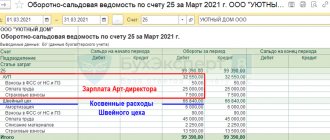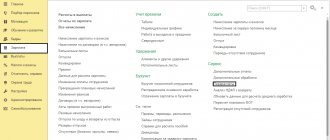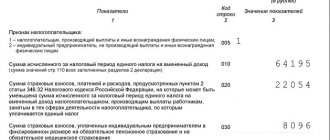As it was before
In the recent past, officials had a unequivocal opinion - it is prohibited to divide the VAT deduction for one invoice into different periods. Such conclusions can be found, for example, in letters of the Ministry of Finance dated December 9, 2010 No. 03-07-11/483, dated October 13, 2010 No. 03-07-11/408 and others. At the same time, the department’s specialists referred to the fact that such a procedure is not provided for by tax legislation. Indeed, Articles 171 and 172 of the Tax Code, devoted to deductions, did not contain rules directly allowing for the “scattering” of VAT deductions.
However, the majority of arbitration courts reasoned differently: firstly, the legislation does not directly prohibit deductions for partial applications, and, secondly, this does not lead to non-payment of tax. Therefore, the arbitrators in most cases recognized the splitting of the VAT deduction as legal. Similar conclusions are given, for example, in the Resolution of the Federal Antimonopoly Service of the Moscow Region dated February 12, 2013 No. F05-15985/12, as well as in many others.
What changed
This contradiction between the positions of the Ministry of Finance and the courts persisted until January 1, 2015. But to the delight of taxpayers, the situation has changed - on the specified date, amendments to the Tax Code came into force. One of them concerned Article 172, which was supplemented by paragraph 1.1 . According to the norm contained therein, it is now possible to claim VAT deductions in any tax period within three years from the date of acceptance of goods for accounting . This gives companies the opportunity to manage the amount of deductions and claim them in the period when they consider it necessary.
In what cases is this convenient? For example, if the taxpayer wants to avoid indicating the amount of VAT to be refunded in the declaration. After all, in doing so, he may be faced with a full-fledged desk audit, within the framework of which the tax service has the right to demand all documents to justify the deduction. And many accountants, in order to avoid this, will prefer to declare the deduction partially, transferring the rest of it to later periods.
How to transfer VAT to the next quarter and meet the deduction deadlines
There are situations when the taxpayer is interested in postponing the VAT deduction to a later period compared to the time when the right to deduction arose. For example, some expensive property has been purchased and the tax return is refundable. How to transfer VAT to the next quarter, is it even possible and in what cases?
The taxpayer has the opportunity to transfer the deduction, but this transfer is not possible for all deductions. Let's consider the issue in more detail.
And in the video below you can find out briefly the most basic information on the topic.
Deadlines for accepting VAT for deduction
In general, VAT deductions are applied in the tax period (quarter) when all the conditions for accepting VAT for deduction :
- goods (work, services), property rights were acquired on the territory of Russia or VAT was paid when importing goods into the territory of the Russian Federation and other territories under its jurisdiction,
- the purchased goods (works, services) will be used in activities subject to VAT, or the purchased goods are planned to be resold,
- purchased goods (works, services) are accepted for accounting,
- there is a correctly executed invoice (UPD).
From January 1, 2015, in accordance with paragraph 1.1 of Article 172 of the Tax Code of the Russian Federation, taxpayers have the right to claim for deduction the amount of submitted VAT in tax periods within three years after registration of purchased goods (works, services).
The transfer of tax deduction applies only to goods (work, services) that are purchased for use in activities subject to VAT or for resale.
Example 1
What are the deadlines for accepting VAT for deduction if the goods were purchased and capitalized in July 2022?
The three-year term will expire in July 2022. Therefore, the VAT deduction on such a purchase can be claimed in the 3rd or 4th quarter of 2022, any quarter of 2022 and 2022, 1st, 2nd or 3rd quarter of 2022. This position is confirmed, for example, by Letter of the Ministry of Finance of the Russian Federation dated May 12, 2015 No. 03-07-11/27161.
In cases where invoices arrive late , it is safer to count the three-year period during which a deduction can be claimed from the date of acceptance of goods (work, services), property rights.
VAT deduction in several parts
The VAT deduction can later be claimed on one invoice in parts in different quarters . This applies to goods, works and services. In relation to goods, these can be both imported goods and goods purchased in Russia both for resale and as inventories used in activities subject to VAT.
How to transfer deductions from advances
Unfortunately, deductions from advances transferred to the supplier cannot be transferred to a later tax period (Letter of the Ministry of Finance of the Russian Federation dated 04/09/2015 No. 03-07-11/20290).
It will also not be possible to transfer deductions from advances received by the buyer. Such deductions should be declared during the period of sale of goods (works, services) for which an advance was previously received. This deduction may extend beyond three years from the date of receipt of the advance, but only if the date of sale itself extends beyond the 3-year period (Letter of the Ministry of Finance of the Russian Federation dated July 21, 2015 No. 03-07-11/41908).
On the other hand, the regulatory authorities do not object to the partial acceptance of VAT calculated on the advance payment to the supplier, considering that the partial acceptance for deduction of VAT listed as part of the prepayment does not contradict the norms of the Code (Letter of the Ministry of Finance of the Russian Federation dated November 22, 2011 No. 03-07 -11/321).
When you can’t offset a VAT deduction later
VAT deductions on business trip expenses and entertainment expenses (Letter of the Federal Tax Service of the Russian Federation dated 01/09/2017 No. SD-4-3 / [email protected] ), as well as VAT paid by a tax agent, cannot be transferred.
When deciding whether to accept VAT for deduction on entertainment expenses, you must remember that such expenses are standardized . If entertainment expenses do not exceed 4% of labor costs for the billing period, then VAT on such expenses can be deducted in full; if they exceed, then in proportion to the income tax expenses accepted for accounting. In the following reporting periods, an organization can take into account VAT that was not previously accepted for deduction if expenses do not exceed the norm of 4%.
So, a VAT deduction later on entertainment expenses can be partially deducted, but within one tax period for income tax (year).
For some deductions, the legislator has determined a special procedure for applying a three-year period for transferring the deduction (for example, goods taxed at a zero VAT rate).
Deduction for fixed assets
Let's consider how to transfer VAT to the next quarter on purchased fixed assets (fixed assets), and whether this is possible.
Previously, regulatory authorities believed that it was possible to claim VAT deduction on purchased fixed assets only after they were put into operation (reflected on account 01). Now the position of the Ministry of Finance has changed, the deadlines for accepting VAT as deduction for fixed assets have changed.
Thus, you can declare VAT when registering the receipt of fixed assets and reflecting them on account 08 (Letter of the Ministry of Finance of the Russian Federation dated 04/11/2017 No. 03-07-11/21548), or transferring them for installation and recording them on account 07 (Letter of the Ministry of Finance of the Russian Federation dated 02/16/2018 No. 03-07-11/9875) for operating systems that require installation.
Example 2
The OS was purchased on June 19, 2018. The purchase amount is 236 thousand rubles, including VAT 36 thousand rubles. Let's assume that if you fill out a VAT return for the 2nd quarter, taking into account the VAT on the purchased operating system, you will end up with an overpayment.
Is it possible to deduct VAT:
1) completely in the 3rd quarter,
2) in parts, for example, partly in the 2nd quarter (6 thousand rubles), partly in the 3rd quarter (15 thousand rubles) and partly in the 4th quarter (15 thousand rubles) of 2022 ?
Solution
1) VAT deduction can be fully claimed in the 3rd quarter in the amount of 36 thousand rubles, or in subsequent quarters until the expiration of the three-year period.
2) From the point of view of the regulatory authorities, it is impossible to declare a deduction of VAT on fixed assets in three parts in different quarters (Letters of the Ministry of Finance of the Russian Federation dated December 19, 2017 No. 03-07-11/84699, dated January 26, 2018 No. 03-07-08/4269) .
Those. In this case, it is possible to transfer the deduction, but dividing it is risky .
How to transfer VAT to the next quarter in certain situations
Case 1
In what period should VAT be divided (for what period should revenue be taken for calculation), if the accounting policy provides for separate accounting of VAT for taxable and non-taxable VAT transactions, and the organization has decided to transfer the deduction?
In our opinion, the calculation of VAT for deduction must be made based on data on revenue and costs during the reporting period when goods (works, services) were accepted for accounting.
It would be correct to indicate this approach in the accounting policy.
Case 2
Is it possible to carry forward the VAT deduction on exported goods?
To answer this question, it is necessary to determine whether the goods are raw materials or non-raw materials.
For non-commodity goods purchased from 07/01/2016, the deduction is transferred in accordance with the general procedure.
For raw materials, there is a special procedure for deducting VAT - during the period of determining the tax base, established by Article 167 of the Tax Code of the Russian Federation. Accordingly, the Tax Code does not provide for the transfer of VAT deductions for such items.
Transfer of tax deduction
Let's summarize. The Code provides for the transfer of the VAT tax deduction for the deductions specified in paragraph 2 of Article 171 of the Tax Code of the Russian Federation.
Despite the fact that for other deductions specified in Article 171 of the Tax Code of the Russian Federation, the transfer of deductions within 3 years of the Tax Code of the Russian Federation does not provide, regulatory authorities recognize the possibility of such a transfer in certain cases:
- In relation to the deductions specified in paragraph 6 of Article 171 of the Tax Code of the Russian Federation in relation to the amount of VAT presented by contractors during capital construction (Letters of the Ministry of Finance of the Russian Federation dated December 8, 2016 3 03-07-10/73279, dated June 16, 2016 3 03-07 -10/34875).
- With regard to the deductions specified in paragraph 13 of Article 171 of the Tax Code of the Russian Federation, according to adjustment invoices when the cost of purchased work increases (Letter of the Federal Tax Service dated June 17, 2015 No. GD-4-3 / [ email protected] ).
We have reviewed the procedure for transferring VAT deductions; if you still have doubts on this issue, share them in the comments to the article.
You might be interested in:
New position of the financial department
The Tax Code still does not contain a direct rule allowing the deduction to be applied in parts - it only clearly allows it to be declared in tax periods within three years after the goods are accepted for accounting. However, now that flexible options for managing the deduction have appeared, the ban on its fragmentation loses all meaning . The position of Ministry of Finance officials has changed, which is reflected in letters No. 03-07-11/20290 and No. 03-07-11/20293 dated April 9, 2015. They conclude that splitting the VAT deduction for one invoice into several tax periods generally does not contradict the Tax Code.
The exception is transactions for the acquisition of fixed assets, equipment for installation and intangible assets - on the basis of paragraph 1 of Article 172 of the Tax Code of the Russian Federation, VAT on them is deducted in full after the said assets are accepted for accounting. In addition, splitting the deduction into several periods is unacceptable for VAT paid as a tax agent, as well as calculated from payment, prepayment and certain other transactions.
Four conditions that allow you to accept VAT as a deduction
The main thing is to comply with all the conditions that are formulated in Article 172 of the Tax Code. There are only four of them:
- Purchased goods, works or services must be purchased for the main production activity or other operations subject to VAT, or for resale.
- Purchased goods must be accepted for accounting. If title under the contract does not pass to you, record the goods in an off-balance sheet account. Please keep in mind that VAT cannot be deducted on such goods.
- An invoice from the supplier must be issued, in which VAT is highlighted as a separate line. In addition, VAT must be indicated on a separate line in invoices, certificates of work performed and services rendered, payment orders, etc. An invoice is the main document confirming the right to deduction.
- If goods are imported from abroad, VAT on them must be paid at customs.
Previously on the topic:
The main prohibitions on VAT deductions: do not transfer and do not split
What does this look like in practice?
What is the procedure for an accountant if it is necessary to declare a VAT deduction in parts in different periods? Let's look at an example.
In the second quarter of 2015, Ajax LLC purchased a passenger car from Avtotrade LLC at a price of 944,000 rubles, including VAT of 144,000 rubles. The purpose of buying a car is further resale. The buyer's accountant decided to claim VAT deduction in equal installments until the end of the current year. Thus, a deduction in the amount of 48,000 rubles (1/3 of 144,000) will be declared in the II, III and IV quarters of 2015.
At the time of purchase, that is, in the second quarter of 2015, the following transactions are made:
| Wiring | Amount (RUB) | Operation description |
| Dt 08 Kt 60 | 800000 | car price excluding VAT |
| Dt 19 Kt 60 | 144000 | VAT amount |
| Dt 68 Kt 19 | 48000 | first part of VAT deduction |
In the same period, an invoice from Autotrade LLC in the amount of 48,000 rubles is registered in the Purchase Book of Ajax LLC.
In the following quarters of 2015, the accountant must repeat the last entry:
| Quarter 2015 | Wiring | Amount (RUB) | Operation description |
| III | Dt 68 Kt 19 | 48000 | second part of the VAT deduction |
| IV | Dt 68 Kt 19 | 48000 | third part of VAT deduction |
In each of these periods, you should also register an invoice from Autotrade LLC in the amount of 48,000 rubles. Thus, the invoice will appear in the Purchase Book not once indicating the full amount of VAT of 144,000 rubles, but three times for 48,000 rubles.
You can enter the second and third parts of the tax into the Purchase Book on any day of the corresponding period. For example, it is quite convenient to do this on the first day of the quarter.
By the same principle, the accountant of Ajax LLC could “split” the VAT deduction not into equal parts, but into arbitrary parts and into any number of periods within a three-year period from the moment the car was registered. Accepting the deduction in parts with “jumping” over one or more quarters also does not contradict the Tax Code. For example, if for some reason Ajax LLC had no sales operations in the fourth quarter of 2015, then it would be logical for the accountant to transfer the last part of the deduction to the first or any other quarter of 2016.
So, let’s summarize the main points of splitting the VAT deduction:
- You can claim part of the deduction in any quarter, the main thing is that the entire amount is “spent” within three years from the moment the goods are registered;
- the declared part of the deduction must correspond to an entry in the Purchase Book made in the same quarter and for the same amount;
- one invoice will be recorded in the Purchase Book several times in different quarters for an amount corresponding to the declared part of the deduction;
- when adding the partial deduction amounts, the VAT amount indicated on the invoice should be obtained.
How to read three years for VAT deduction
In 2015, the rule for calculating the three-year period was formulated by the Constitutional Court in its ruling dated March 24, 2015 No. 540-O: “the date of occurrence of the obligation to pay VAT, the amount of which is determined taking into account the declared deductions, is the date of the end of the tax period, and not the date of submission of the tax return "
In 2022, clarifications were issued in the Resolution of the Supreme Court of the Russian Federation of August 24, 2022 No. 308-ES21-13958. The verdict of the senior judges reads:
- claiming a deduction means reflecting it in the VAT return;
- 3 years for obtaining a VAT deduction are counted from the date of acceptance of goods for registration.
Thus, the period when the right to deduction is lost expires on the last day of the quarter in which the end of this 3-year period falls. It cannot be extended by the days allotted for filing a VAT return for this quarter.
So how do you claim a deduction on an invoice issued 3 years ago?
Read in the berator “Practical Encyclopedia of an Accountant”
What to do if the invoice arrived after the end of the reporting quarter
You need to do the following:
- record the invoice in the purchase ledger for the corresponding quarter 3 years later;
- declare the deduction in the declaration for this quarter and submit it no later than the last day of this quarter.
Only in this way will the 3-year deadline for deduction be met. It is not extended for the period of submission of the declaration.
Deduction of VAT in parts and reconciliation of the Federal Tax Service
As you know, since the beginning of this year, the tax service has been carefully monitoring all VAT payers, processing their electronic reports automatically. At the same time, information from the books of purchases and sales of counterparties is compared, which have now become part of the expanded tax return. For each transaction, the data specified by the seller and the buyer are compared, including the amount of VAT.
However, if the buyer decides to “split” the deduction into several periods, then VAT will be partially reflected in his Purchase Book, which will not correspond to the entry in the supplier’s Sales Book. When conducting a cross-reconciliation at the end of the quarter, the tax office will identify this discrepancy and may require an explanation. Moreover, based on clause 8.1 of Article 88 of the Tax Code of the Russian Federation, the inspectorate will be able to demand the presentation of an invoice and other documents regarding the transaction, because formally the amount of tax in the buyer’s declaration will be underestimated. As a result, some accountants still prefer not to split deductions due to reluctance to communicate with the Federal Tax Service or fear of sanctions.
But according to many experts, it is completely safe to deduct VAT in parts. Of course, there is a risk of receiving a request from the inspectorate to provide explanations. But since by declaring a partial deduction, the buyer does not violate tax laws, he will be able to explain his actions, submit the necessary documents and without any problems “justify” the incomplete amount of VAT.
How much time do you have to transfer the VAT deduction?
If all the conditions that give the right to deduct input VAT are met and the operation falls into the category of those for which the transfer of deductions is not prohibited, the deduction can be claimed within 3 years.
So what does the expression “claim a deduction within 3 years” mean?
Registering an invoice in the purchase ledger? Or submitting a declaration where in section 3 the deduction that was paid to the supplier is indicated?
Let's say you "claimed a deduction" by fulfilling all the conditions for it and making an entry in the purchase ledger. Then, based on the results of the quarter, on the 25th of the next month, they submitted a declaration. In it, in section 3, they “claimed a deduction.” This is correct for filing a declaration and complies with the code. Will it turn out that the 3-year period for deduction has been missed?
Here lies the danger that the VAT deduction on a three-year invoice can be lost. But we will not find any explanation in the Tax Code of the Russian Federation.









